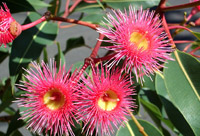It is taken that you have read our Disclaimer and Privacy Policy on entering this website
"Everyone has the right to freedom of opinion and expression; this right includes freedom to hold opinions without interference and to seek, receive and impart information and ideas through any media and regardless of frontiers"
Article 19 UN Declaration of Human Rights to which Australia is a signatory
A Grin Without a Cat
an antigen-antibody reaction without a single molecule of antibody serum

Original version of this essay published in Curentur of the Australian Association of Professional Homoeopaths. June 1999.
Homeopathy aserts that highly dilute and succussed (energized) solutions are bioactive.
According to scientific criteria for validity, this statement is capable of refutation; it is capable of being falisified by demonstration and experiment. Yet it never has been falsified according to scientific method.
Thus by scientific criteria: It Stands . And As It Stands, this claim is physical chemistry's own version of the Cheshire Cat.
"When to Believe the Unbelievable" was the editorial comment when Nature, one of Britain's most prestigious research journals published the results of the Benveniste experiment.
Reluctantly, the editor, John Maddox, invited readers to understand the chagrin of the peer review which had required the Benveniste experiment to be duplicated in seventy repeat and double blind trials by universities in France, Canada, Israel and Italy.
In the end, publication had to be conceded and the international scientific community was to confront the famous grin sans Cat with no apologies to Wonderland.
The peer reviewed experiment and its findings: "Human Basophil Degranulation Triggered by very Dilute Antiserum Against IgE" (1) went to press on June 30, 1988.
And by Very Dilute – what is meant is: diluted past Avogadro's Constant. Not a single molecule of of antibody serum was present in the antiserum used in the Benveniste experiments.
"Impossible Idea Published on Purpose", as it was dubbed by The New York Times (2) was a set of experiments conducted at the University of Paris-Sud by French immunologist Professor Jacques Benveniste of the French Medical Research Council. His facility at the University is internationally recognized for its work on mast cells and immunology.
Benveniste's experimental design began with a goat antibody to a human immunoglobulin (IgE). Utilizing the homeopathic method of ultradilution, one drop of the original goat antibody solution was diluted with distilled water and succussed (struck down) up to 120C or centissimal potency with a vortex rotation. It was then ultrafiltered through membranes with a pore size of less than 10k Da. The potency was then introduced as an antiserum into a a human basophil.
The Benveniste experiments recorded that the ultra high dilution (UHD) of the goat antibody:
1 - attacked the IgE as if it still contained the original antibody material and
2 - stimulated human basophil degranulation.
The Homeopathic community in France probably yawned over its coffee and croissants. But the outcry at the University of Paris-Sud was so extreme that Professor Benveniste was compelled to employ a baliff at his facility and agree to direct supervision by the Dean of the medical school in order that accusations of fraud be put to rest. (3) Why?
The laws of physical chemistry hold that Benveniste's final dilution and succussion would have statistically eliminated all molecules of the original goat antibody because it was diluted past Avogadro's Constant. (4) Further, the UHD had been subjected to ultrafiltration. Theoretically the antiserum of the goat antibody in UHD was just distilled water.
Therefore, according to physical law, the UHD can not cause a chemical reaction. The physical law of chemistry holds that in order to have a chemical reaction there must be mass that causes reaction. Otherwise, there exists the 'impossibility' of a physical effect without a physical cause; an antibody-antigen reaction without an antibody; a grin without a Cat.
In 'defiance' of physical law, what Benveniste and his research team had was an homeopathic potency (their UHD antiserum) which they applied to the human basophil confident that a non event would be observed. However, instead of gradually diminishing with dilution and succussion, as it was obliged to do, the UHD antiserum increased in strength. They had to measure the peaks of its action as a wave of reaction in the basophil. However, water that had never been in contact with the antiserum produced no reaction in the human basophil. And there was no reaction with UHD solutions that had not been subject to succussion. Likewise there was no reaction if the UHD was heated, cooled or treated with ultrasound.
I expect that there would also have been no reaction if the UHD had been subjected to any of the don'ts listed on the label of any homeopathic potency: Keep away from sunlight, heat, radiation, cold, etc.
Ms. Patricia Fortner, a theoretical physicist who worked on the Benveniste experiment at the University of Toronto, told The Toronto Globe and Mail that as a scientist she was much excited because the experiment demonstrated a kind of biomagnification in UHD succussed substances. ( 5 ).
Not so the deputy editor of Nature, Dr Peter Newark. "If these results come to be ruled as valid" he glommed, "then we will have to abandon two centuries of rational thinking about biology because they can not be explained by physlical law." ( 6 ) I am not making this up. The history of science itself is a history of revolutions in paradigmatic thinking ( 7 ) and in the face of the Benveniste results, Dr Newark felt abandoned by both reason and physical law. Here is a man who missed his vocational calling. Instead of science, he should have taken up the contemplation of eternal verities in a subject like theology.
Meanwhile, back at the ranch, more inquiring minds were coping well. They were thinking less in terms of an abandonment of rational thought than an opportunity to re-envision physical law in a way that would explain the kind of energetic basis to physical effect measured by Benveniste. To the Professor, the experiment also raised questions about the role of water in the origins of life.
The molecular organization of humble H2O would seem to allow it to 'memorize' the imprint of a diluted substance as an image and to retain that imprint in dilution past Avogadro's Constant. When this image is energized, the scientists speculated, perhaps what was being observed was something in biochemistry 'like a motion picture': the movies of medicine? How could this be? No one knows – yet.
Not one to dim his headlights for the oncoming traffic, Professor Benveniste asserted (on page one of Le Monde) that no less than a new physics of biochemistry would be developed to explain the results of his experiments. ( 8 ).
But, Across the Channel, it was raining and the horizon was low. "The establishment (probably that should be spelled with a capital E) can not fault the experiment" was the best that could be done in the only London paper to carry the story, The Independent. ( 9 ) Yes some prominent Egos and even more prominent reputations were v v not amused.
Still, "it is a bit unfortunate" sniffed Dr Newark, "that this paper could be seen as lending credibility to the homo – eo – path – ists." ( 10 ) Well. Raaather, one would think, if one was following this debate.
And this had probably been Nature's bottom line all along. As if "abandoning two centuries of rational thinking" were not bad enough, now – to crown all – this experiment horribilus would establish a basis for "The H word" in both physics AND chemistry. And We certainly can't have that.
The Professor had no words of reassurance to offer. In fact, he related that the entire affair had begun as a bet with two of his amis: Mssrs Bernard Poitevin and P. Belon, whom he ackowledged in his research as his "homeopathic colleagues".
"They challenged the classical scientists like ourselves to prove them wrong and we couldn't" ( 11 ) concluded Benveniste.
Thus, an experiment that by all accounts will necessitate a re envisioning of physical law across all scientific disciplines – if a way could not be found to invalidate Benveniste's conclusion. (And no effort would be spared). Even so, it should be recorded how many francs the unsung homeopaths put down for a scientific revolution.
Notes: ( 1 ) Nature. 1988. Vol. 33, p. 816-818. ( 2 ) Browne, Malcome. "Impossible Idea Published on Purpose" The New York Times 30 June 1988. ( 3 ) Strauss, Stephen "New Discovery Leaves World Scientists Confounded" The Toronto Globe and Mail. 30 June 1988. Submitted over HomeoNet by Louis Klein, published by Brauer Biotherapies Inc. ( 4 0 Avogadro's Law states 24 that dilutions of any substance beyond 10 (in Homeopathic terms: 12C) has eliminated every molecule of the original substance in all probability. ( 5 ) Strauss, Op. Cit. ( 6 ) Ibid. ( 7 ) Kuhn, Thomas 1962. The Structure of Scientific Revolutions. The University of Chicago Press, Chicago. ( 8 ) Le Monde 30 June 1988. ( 9 ) Wilke, Tom "Effect Without a Cause Has Scientist Baffled" The Independent. London. 30 June, 1988. (Submitted over HomeoNet by Robert Davidson, published by Brauer Biotherapies Inc. ( 10 ) Browne Op. Cit. ( 11 ) Ibid.

The Hahnemann Monument in Washington DC
























